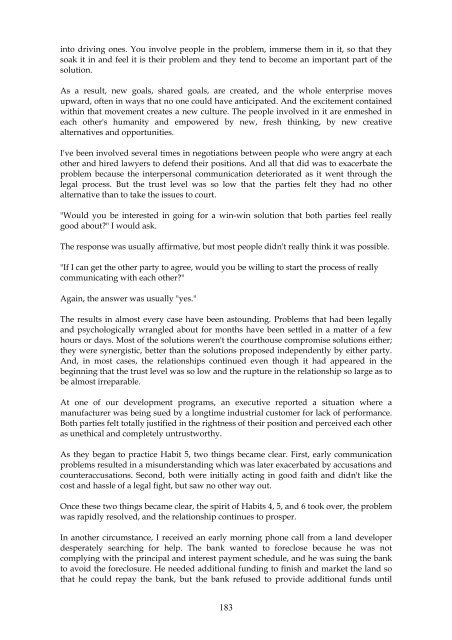Covey - The 7 habits of highly effective people
Create successful ePaper yourself
Turn your PDF publications into a flip-book with our unique Google optimized e-Paper software.
into driving ones. You involve <strong>people</strong> in the problem, immerse them in it, so that they<br />
soak it in and feel it is their problem and they tend to become an important part <strong>of</strong> the<br />
solution.<br />
As a result, new goals, shared goals, are created, and the whole enterprise moves<br />
upward, <strong>of</strong>ten in ways that no one could have anticipated. And the excitement contained<br />
within that movement creates a new culture. <strong>The</strong> <strong>people</strong> involved in it are enmeshed in<br />
each other's humanity and empowered by new, fresh thinking, by new creative<br />
alternatives and opportunities.<br />
I've been involved several times in negotiations between <strong>people</strong> who were angry at each<br />
other and hired lawyers to defend their positions. And all that did was to exacerbate the<br />
problem because the interpersonal communication deteriorated as it went through the<br />
legal process. But the trust level was so low that the parties felt they had no other<br />
alternative than to take the issues to court.<br />
"Would you be interested in going for a win-win solution that both parties feel really<br />
good about?" I would ask.<br />
<strong>The</strong> response was usually affirmative, but most <strong>people</strong> didn't really think it was possible.<br />
"If I can get the other party to agree, would you be willing to start the process <strong>of</strong> really<br />
communicating with each other?"<br />
Again, the answer was usually "yes."<br />
<strong>The</strong> results in almost every case have been astounding. Problems that had been legally<br />
and psychologically wrangled about for months have been settled in a matter <strong>of</strong> a few<br />
hours or days. Most <strong>of</strong> the solutions weren't the courthouse compromise solutions either;<br />
they were synergistic, better than the solutions proposed independently by either party.<br />
And, in most cases, the relationships continued even though it had appeared in the<br />
beginning that the trust level was so low and the rupture in the relationship so large as to<br />
be almost irreparable.<br />
At one <strong>of</strong> our development programs, an executive reported a situation where a<br />
manufacturer was being sued by a longtime industrial customer for lack <strong>of</strong> performance.<br />
Both parties felt totally justified in the rightness <strong>of</strong> their position and perceived each other<br />
as unethical and completely untrustworthy.<br />
As they began to practice Habit 5, two things became clear. First, early communication<br />
problems resulted in a misunderstanding which was later exacerbated by accusations and<br />
counteraccusations. Second, both were initially acting in good faith and didn't like the<br />
cost and hassle <strong>of</strong> a legal fight, but saw no other way out.<br />
Once these two things became clear, the spirit <strong>of</strong> Habits 4, 5, and 6 took over, the problem<br />
was rapidly resolved, and the relationship continues to prosper.<br />
In another circumstance, I received an early morning phone call from a land developer<br />
desperately searching for help. <strong>The</strong> bank wanted to foreclose because he was not<br />
complying with the principal and interest payment schedule, and he was suing the bank<br />
to avoid the foreclosure. He needed additional funding to finish and market the land so<br />
that he could repay the bank, but the bank refused to provide additional funds until<br />
183


